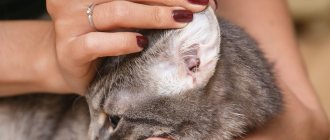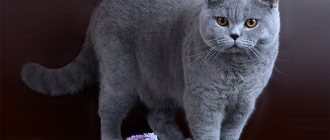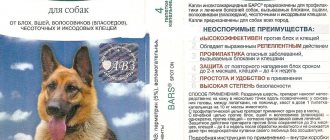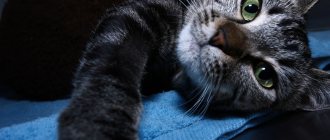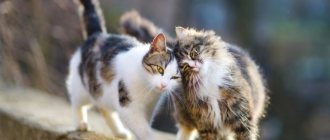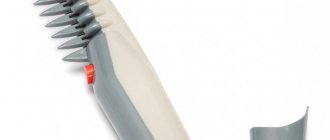Factors influencing cat behavior
All cats behave differently. This is due to many factors:
- character and temperament, which largely depend on the breed. Thus, Siamese cats are jealous and capricious, but Maine Coons are kind, so they are best chosen by families with children. Outbred cats can have very different personalities, because it is not clear from which breeds they originated;
The behavior of a cat depends on the breed, for example, Maine Coons are generally friendly
- education. For a cat to grow up kind and affectionate, you need to talk to it, play with it, and take care of it. And on the contrary, for owners who devote little time to the animal, it can behave vindictively - shit in the slippers and on the bed, etc.;
- socialization. Sociopathic cats do not accept anyone at all (they do not allow themselves to be stroked, do not make contact, etc.), except perhaps the owner when he offers food. It is usually not easy with such animals, but at the same time they do not require much attention;
- trust in people. If you call a cat on the street, he may not come up because he is afraid of humans. This is usually how pets behave. And those who do not have a “roof over their ears” usually run up to be fed, but not all of them either. If a cat has been frequently abused, it may be afraid of everyone around it and not approach a person. Such stressed animals need rehabilitation - they need to be gradually accustomed to normal relationships with humans.
A cat living outside may be scared, which may cause her to not trust humans.
What does scratching mean?
In general, scratching in cats is often regarded as aggressive behavior. But this does not always indicate the bad character of the animal. If the kitten is small, then this is quite acceptable. After all, this is how he understands the world. Yet these “cute creatures” are predators by nature.
But sometimes even adult cats strive to bite or scold their owner. In this case, your pet has a very highly developed hunting instinct . He perceives your moving legs and arms as “prey.” To satisfy the desire of the “hunter”, purchase special toys for him.
Sometimes curtains and furniture suffer from scratching. Cats don't do this out of spite. When scratched on the surface, they remove old nail scales. And they also keep the paw muscles toned. Damaged furniture and curtains are not pampering for them, but a necessity. Therefore, you should think about buying a scratching post.
Cat behavior after sterilization and castration
Sterilization and castration are two different operations. Accordingly, after each of them cats behave differently.
A little about the terms
Sterilization is an operation to ligate the fallopian tubes in cats and the seminal ducts in cats (vasectomy). After it, the animal’s genitals remain in place and continue to produce hormones. Under their influence, the pet will still experience hormonal storms. Therefore, he may often experience stress, which is why he shows aggression. In addition, when sterilized, the animal often loses weight because it refuses to eat. It has the ability to mate, but not produce offspring.
Sterilization involves ligation of the fallopian tubes in cats and the seminal ducts in cats
Castration involves complete removal of the genitals. In a cat, these are the ovaries, which are often removed along with the uterus; in a cat, both testicles. Features of behavior - the animal stops marking its territory and screaming.
Cat behavior in the first days after surgery
The first day after sterilization or castration, most cats recover from anesthesia and therefore sleep. Typically, an animal's sleep lasts about 5–6 hours. When it wakes up, it makes several unsuccessful attempts to rise. If your cat manages to get up, be prepared for the fact that at first she will have poor orientation in space, falling and bumping into objects.
On the first day after sterilization, the cat is lethargic
The animal may try to hide, meow and call for help. In the first day or two after sterilization, you need to limit the cat’s interaction with children or other animals, as some pets behave aggressively after anesthesia. If this condition lasts more than 3 days, consult a veterinarian.
When you return home with your animal, wrap it in a warm blanket, since the cat’s body temperature usually drops after anesthesia. Do not place your pet in a place where he can fall (for example, on a chair) - it is better to place him on the floor, on a lounger. Don’t expect that after sterilization the animal will immediately want to eat - try to at least offer it water. By the evening of the second day, the cat should already show interest in food and become active.
Your pet may become aggressive when you touch its belly, and this is normal . However, you will still have to inspect the seams. Typically, 7–10 days after surgery, the animal completely returns to normal life.
Some owners note that after sterilization, their pets become more affectionate and more often ask to be held.
Our behavior changed after castration, well, we have a cat, and this cat really loved the water and began jumping into the bath so that they could play with him in the water.)))
Alekseevna
https://otvet.mail.ru/question/39099147
Buries food
Burying food is one of the most common habits in cats. Reasons for this behavior:
- Some pets bury food because they like it. This usually happens after changing the usual ready-made food for a new one or after the four-legged pet was offered a self-prepared dish that he had not tried before. Not knowing whether he will have a chance to taste the tasty treat again, the animal tries to hide it so that he can enjoy it again later.
Sounds and facial expressions of a cat when communicating with a person
Every cat sound carries meaning. If you know which one, your relationship with your pet will certainly become better.
Hiss
A cat's hissing is a warning. The animal seems to say: “Don’t come near me.” A cat doesn't hiss just like that - it usually happens when it is very worried or scared about something. If so, move away from your pet and give him a chance to calm down.
If a cat hisses, it warns you not to approach it.
The animal defends itself from strangers.
Even ours hissed for about 4 years on a child, they did nothing. Gradually I got used to it, now I can at least iron it. And how are you going to “put her in her place”? Will you knock? So this is not a method, it will be even worse. Toril-or-Twine
https://www.u-mama.ru/forum/family/pets/693840/
Snort
If a cat is angry, it may snort. In this case, do not disturb the animal and wait until it calms down. Snorting may also be due to the fact that the cat inhaled dust and got rid of it on its own. This is not a big deal if it happens rarely, so there is no need to do anything special.
When a cat rubs its nose with its paws while snorting, it experiences obvious discomfort. The reasons for this may be the following:
- itching and burning in the nose due to the onset of a runny nose, in which there is no discharge yet or there is already one;
- ingestion of irritants or particles into the nose;
- sinusitis (inflammation of the paranasal sinuses);
- inflammation of the tooth root, in which pain often radiates to the nose;
- foreign body in the nasal passage.
Therefore, if your animal snorts, you should contact a veterinarian. After all, it’s better to make a mistake than to miss a serious problem.
I brought a cat from Germany a week ago.
And, I think, she caught a cold at the airport in Moscow. The first two days everything was fine, but on the third she almost stopped eating, slept almost all the time and seemed to snort through her nose. She didn’t sneeze, but as if something was preventing her from breathing and she was trying to blow air out of her nose (sorry, I don’t know how else to explain it) I thought it was stress and so on. But today I noticed that snot was flowing from my nose. Such a transparent liquid. I took her to the doctor. The doctor measured the temperature (for some reason he did not listen to the lungs) The temperature turned out to be 40.5. The doctor said that it was a cold and prescribed the following medications: Cefazolin (diluted with novocaine) twice a day for seven days Cycloferon once a day for three days, and then every other day five more days. Baralgin, if the temperature is above 39 Chilla
2https://forum.mau.ru/viewtopic.php?t=61187&sid=2bdef9e4df3ceb7220adc9aeb26b0eba
Purr
Purring will “tell” about the cat’s good mood, its gratitude for affection or a delicious dinner. But a pet may purr due to hunger or fear. Surely many are familiar with the situation when a cat was playing with its owner and purring, and suddenly released its claws. This means that she is tired of the game. Or affection, if she was stroked. Therefore, in such a situation, hurry to leave the animal alone.
Purring not only “tells” about a cat’s good mood, but also helps it recover
It turns out that purring at frequencies of 20 and 140 hertz contributes to:
- healing of bones and tendons caused by injuries;
- helps with shortness of breath;
- relieves pain;
- improves the condition of edema.
This conclusion was made by British scientists who published the results of the study in the journal Current Biology. Scientists have also found that purring heals not only the cats themselves, but also those around them.
Long "meow"
A loud, prolonged scream, more like a howl, will tell you that the cat is excited or angry and is ready to attack. At times of such “calls” it is better to refrain from communicating with the cat.
Mine does this all the time.
When he sees that I’m about to go out straight to the door, he wants to go out first. When I close the door behind me, I immediately start crying. And so every day twice. When I take my child to school in the morning and when I go to pick him up from school in the afternoon. Mom says that she sits near the door and meows for a long time until I return. When I return she follows me and meows. I talk to her, and she seems to be complaining. And so on until I change into home clothes. Then she calms down and goes to lie down somewhere on the windowsill. A couple of times I left on business for a longer time, about 3 hours. I returned, and she was near the door, already on the floor I heard her meowing. I go in and look, and there are wet marks under her eyes. When she worked, she would leave for the whole day, so my mother said that she would sit until lunch, meowing, and not listening to anyone. Then he goes to bed. And in the evening, just before I arrive, he runs to the door meowing, and after 2-3 minutes I return home. I can’t imagine what will happen when I go to work, because then she will be left all alone. It’s probably better not to think about a vacation abroad at all. nyuwuk
https://forum.ykt.ru/viewtopic.jsp?id=4165394
Video: cats meow protractedly in the garage
Cooing short "meow"
You come home, and the cat makes pleasant short sounds, reminiscent of cooing. This is how the animal greets you - it “says” that it is glad to see you. At these moments you can pet your pet and talk to him.
Choosing a kitten
The habits of all cats are generally similar. But how can you find out about the character of an animal if it is a small kitten? How to determine who we choose for ourselves?
There is a theory according to which hormones influence their development. They have an effect on both the body and behavior. Therefore, these two factors are connected, which means that the kitten must be selected based on the expression of its face.
When choosing, you also need to pay attention to your parents. Since kittens are constantly with their mother while growing, they have time to learn basic skills.
Scientists have proven that cats - fathers influence habits and preferences even in the embryonic period. Therefore, if possible, take a closer look at your parents.
The breed plays the biggest role in a cat's character. Therefore, first of all, you need to choose a suitable breed. The period of socialization of a kitten takes place in the first four months. All the skills he can acquire will last a lifetime. Therefore, the owner’s task is to teach his pet everything necessary. And in the end, get maximum positive energy and joy from communicating with this independent creature.
Why do cats hiss when they sense danger?
Many people have repeatedly witnessed “cat fights.” When a cat attacks an enemy, it presses itself to the floor, lowers its ears and emits a terrible hiss. This is explained by the fact that cats are able to imitate and imitate various sounds. Therefore, smart animals chose to imitate a creature that they are practically afraid of - a poisonous snake. The cunning cat's brain understands that hissing is intuitively associated with a snake. That is why, in order to scare the enemy, the cat hisses.
Crushes the owner or upholstered furniture with his paws
Cats mash their owners with their paws because:
- they feel completely safe, just like in childhood, when, as kittens, while feeding, they kneaded their mother’s breasts with their front paws to increase the flow of milk to her nipples;
- they experience true pleasure, and the only way to express gratitude and love to the owner is to sit on his lap and look into his eyes, touching his paws;
- they want to protect a loved one from invisible enemies, leaving odorous marks on him with the help of sweat glands located on the paw pads;
- do therapeutic massage.
These animals crush furniture with their paws to:
- prepare her for bed;
- relieve stress (rhythmic, monotonous movements help them quickly calm down);
- realize sexual instinct during the mating season;
- mark the object of trampling.
Description of the Scottish Straight cat
Scottish cats differ in a number of characteristic features that are unique to this breed. Sometimes animals are often confused with the British species, but during the comparison process the following differences can be identified:
- more rounded head;
- the body has an oblong and elongated shape, which gives the animal elegance;
- body proportions are slightly reduced;
- the average weight of a cat is 3 - 5 kg, boys weigh slightly more than females;
- pets are very flexible and remain hardy and playful at any age.
Habit of climbing higher
The habit of climbing on high objects (not every cat has this feature) has 2 justifications:
- Felines do this to realize the territorial feeling inherent in nature. These animals adhere to a hierarchical model of relationships. The owner of the territory climbs to a height - this way he can take in all his possessions with his gaze, which allows him to control the situation and, if necessary, descend, subjugating other relatives or entering into battle with them.
- Cats climb to heights because they feel in danger, which comes, for example, from a dog.
The cat brings caught mice, birds and even rats - dead and half-dead
If a cat brings caught rodents and birds to the owner, most likely, in this way she shows maternal feelings when all her forces are aimed at finding food for the cubs. Some animals, with the help of such an original gift, which seems quite appropriate to them, show their owners their tender feelings or gratitude.
Another reason for this behavior is the animal’s desire to teach its owner hunting skills. For this purpose, the pet does not bring killed, but only strangled mice and birds.
Harmful cat habits
Not all cat habits are liked by owners; some habits create difficulties for people keeping a pet in an apartment:
Scratching furniture
Sharpening their claws is a natural need, this is how animals remove excess length and clean off the stratum corneum. It is necessary to install a scratching post and teach the cat to use it, strictly preventing attempts to tear up furniture, wallpaper, carpets, and floor coverings.
Tags
Sexually mature cats leave fragrant business cards on the corners of walls, legs of tables, and cabinets. This is how they indicate their right to territory and declare to females that they are ready to mate.
The acrid smell of the secretion is difficult to evaporate, absorbing into the surface. To avoid an unpleasant spirit in the house, to save yourself from unnecessary suffering, and the animal from illness, attempts to break free, it is recommended to castrate the cat. Especially if the owners do not plan to engage in breeding.
Eating out
Cats walking outside on their own can eat offerings from compassionate passers-by and food waste. Stale food causes poisoning, infectious diseases, indigestion, and vomiting. Particularly dangerous are the linings of “cathunters” stuffed with crushed glass and the points of fishing hooks.
Be sure to read:
How to scare cats away so that they don’t shit, mark and damage furniture, what smell they can’t stand
Utility companies leave out poisonous food to kill rats, but cats can also fall prey to coumarin. It is necessary to feed your pet well before leaving, and it is better to prevent self-walking.
Talkativeness
Intrusive meowing can be irritating for some owners. In this way, the cat signals hunger, fear, anxiety, and pain. Increased talkativeness is unusual for cats; once you figure out the reason, the animal immediately stops talking.
Keeping cats is a fascinating process; intelligent animals adopt the atmosphere of the house and their owners. It's funny to watch them play, fuss with children or other pets, and develop their character as they grow older. Some cat habits have become an inexhaustible source of memes, jokes, and funny videos. Share in the comments which pet habits you like and which you don’t?
Love for drawers, boxes and cabinets
What does it mean that cats love boxes, drawers and cabinets and have an irresistible desire to hide in them? This feature is explained by the desire for privacy. This habit was passed on to modern pets from their wild ancestors, who were forced to live in harsh conditions, sometimes hiding in secluded places from the predatory animals that hunted them.
In a residential area, cats are not in danger of becoming victims of an enemy, unless we are talking about them living in the same territory with dogs with whom they do not have a good relationship. However, they retained the habit of hiding in secluded places.
Places itself to rest in the most inappropriate places (aisles, on the keyboard, etc.)
Pets sometimes disturb the inhabitants of the home, resting in the passages, occupying the space near interior doors and computer keyboards. Is there any special meaning to this behavior? The tendency of cats to settle in inappropriate places can be explained by the desire to mark boundaries.
Representatives of this family consider the territory on which they live, as well as everything that is on it, to be theirs. By being located in doorways, they demonstrate to the inhabitants of the home, including other animals, that it belongs to them. In addition, by staying in the passages, cats try to cool themselves, since it is in such places that air circulates best in the house. They usually behave this way in the warm season or if the home is too hot.
Perhaps this behavior is also due to the fact that the pet, clearly disturbing the inhabitants of the house, is trying to attract attention to itself in such a simple way. Indeed, it’s hard not to notice the cat, which is sitting imposingly on the keyboard. You shouldn't chase him away. It is better to take your four-legged pet in your arms and spend some time with it.
How can you understand your cat by gestures?
Love for animals is a better means of understanding behavioral reactions. I do all of them automatically:
- Nervous twitching or sharp wagging of the tail expresses dissatisfaction;
- raised tail (slightly curved) – good mood and trust in others;
- when frightened or confused, the tail is tucked or fluffed, if the animal is ready to attack another cat or dog (in this regard they are more ferocious), it also hisses with its ears tucked back;
- if the tips of the ears are apart, she is perplexed, raised to the top of the head - a decision has been made, directed forward - interest or recognition of signals.
Sometimes cats scare their owners with their behavior. For example, in complete darkness, when the light comes only from a monitor or gadget, the animal peers at one point with sharply dilating pupils. This does not mean that the cat saw a brownie there (although it is possible); most likely, a spider is descending, the cat is “sharpening.”
Animals are no less emotional than people; they suffer from loneliness in a closed apartment and entertain themselves as best they can. Sometimes they stare at one point for a long time, “freeze”, withdrawing into themselves - the consequences of the stress they have suffered.
Some mark their territory endlessly, others don’t; perhaps they don’t like the smell of a smoky apartment. There are many signs and interpretations of their behavior, so you should not punish the animal. Just try to understand it - look at the world through the eyes of cats.
Sometimes he curls up into a ball, sometimes he stretches out in his sleep.
Curling up in their sleep is a typical behavior for many cats. It is not difficult to understand why they choose this particular position. Curling up into a ball, tucking their paws under them and wrapping their tail, they just want to keep warm. Animals usually sleep this way in the cold season and when the house is cool.
Another reason for this position in sleep is to protect the internal organs from a possible attack by the enemy. Modern representatives of this family inherited this feature from their wild ancestors, who, even in a sleepy state, were on alert so as not to become prey to predatory animals. Pets are not in danger, but they still sleep curled up in a ball.
Sleeping animals periodically stretch out to stretch their stiff bones. This position indicates that the four-legged pet feels completely safe. Cats sleep in the same position when they are hot.



